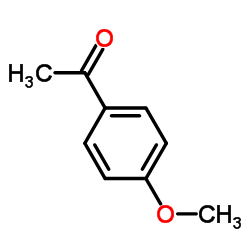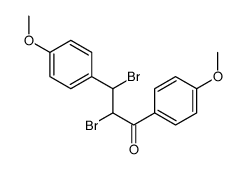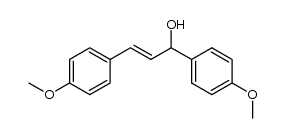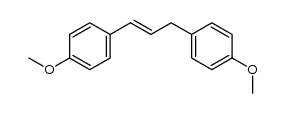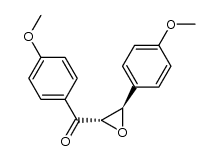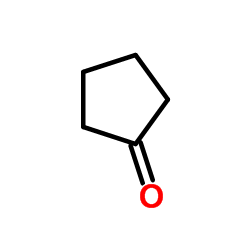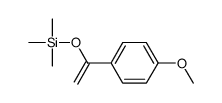2373-89-9
| 中文名 | 4,4’-二甲氧基查耳酮 |
|---|---|
| 英文名 | 4,4'-dimethoxychalcone |
| 中文别名 | 4,4-二甲氧基查尔酮 |
| 英文别名 |
MFCD00025815
4,4'-DIMETHOXYBENZYLIDENEACETOPHENONE DIMETHOXYCHALCONE,4,4'-(RG) 4,4'-dimethoxy-chalcone 1,3-bis-{4-methoxy-phenyl}-propen-(1)-one-(3) 1,3-bis-(4-methoxyphenyl)-propenone 2-Propen-1-one,1,3-bis(4-methoxyphenyl) 1,3-BIS(4-METHOXYPHENYL)PROP-2-EN-1-ONE (E)-1,3-BIS(4-METHOXYPHENYL)PROP-2-EN-1-ONE DIMETHOXYCHALCONE,4,4' 4,4'-Dimethoxy-chalkon |
| 描述 | 4,4'-Dimethoxychalcone 可从植物当归中分离得到,是一种天然自噬 (autophagy) 诱导剂,具有抗衰老活性。 |
|---|---|
| 相关类别 | |
| 靶点 |
Autophagy[1] |
| 体内研究 | 黄酮类化合物4,4'-二甲氧基查尔酮是一种抗衰老化合物,对小鼠具有心脏保护作用,有可能促进物种间的长寿[1]。4,4'-二甲氧基查尔酮(100 mg/kg;腹腔内)有效地触发野生型(WT)C57BL/6小鼠心脏和肝脏的自噬通量[1]。动物模型:6周龄雄性野生型C57BL/6或Atg4b-/-小鼠[1]剂量:100 mg/kg给药:腹腔注射,结果单一:触发心脏和肝脏的自噬通量。 |
| 参考文献 |
| 密度 | 1.128g/cm3 |
|---|---|
| 沸点 | 444.6ºC at 760 mmHg |
| 熔点 | 101°C |
| 分子式 | C17H16O3 |
| 分子量 | 268.30700 |
| 闪点 | 214.6ºC |
| 精确质量 | 268.11000 |
| PSA | 35.53000 |
| LogP | 3.59990 |
| 蒸汽压 | 4.23E-08mmHg at 25°C |
| 折射率 | 1.591 |
| 储存条件 | 保持容器密封,放入紧密的出藏器内,储存在阴凉,干燥的地方 |
| 稳定性 | 避免氧化物接触 |
| 分子结构 | 1、 摩尔折射率:80.46 2、 摩尔体积(m3/mol):237.8 3、 等张比容(90.2K):604.3 4、 表面张力(dyne/cm):41.6 5、 极化率(10 -24cm 3):31.89 |
| 计算化学 | 1、 疏水参数计算参考值(XlogP):3 2、 氢键供体数量:0 3、 氢键受体数量:3 4、 可旋转化学键数量:5 5、 互变异构体数量: 6、 拓扑分子极性表面积(TPSA):35.5 7、 重原子数量:20 8、 表面电荷:0 9、 复杂度:321 10、同位素原子数量:0 11、确定原子立构中心数量:0 12、不确定原子立构中心数量:0 13、确定化学键立构中心数量:1 14、不确定化学键立构中心数量:0 15、共价键单元数量:1 |
| 更多 | 1. 性状:黄色晶体状粉末 2. 密度(g/L,20ºC):未确定 3. 相对蒸汽密度(g/mL,空气=1):未确定 4. 熔点(ºC):100-102 5. 沸点(ºC,常压):未确定 6. 沸点(ºC 35mmHg):未确定 7. 折射率(nD20):未确定 8. 闪点(ºF):未确定 9. 比旋光度():未确定 10. 自燃点或引燃温度(ºC):未确定 11. 蒸气压(Pa,20ºC):未确定 12. 饱和蒸气压(kPa,20ºC):未确定 13. 燃烧热(KJ/mol):未确定 14. 临界温度(ºC):未确定 15. 临界压力(KPa):未确定 16. 油水(辛醇/水)分配系数的对数值:未确定 17. 爆炸上限(%,V/V):未确定 18. 爆炸下限(%,V/V):未确定 19. 溶解性:不能溶解的 |
|
SECTION 1: Identification of the substance/mixture and of the company/undertaking Product identifiers Product name: 4,4'-DIMETHOXYCHALCONE REACH No.: A registration number is not available for this substance as the substance or its uses are exempted from registration, the annual tonnage does not require a registration or the registration is envisaged for a later registration deadline.
CAS-No.: 2373-89-9 Relevant identified uses of the substance or mixture and uses advised against Identified uses: Laboratory chemicals, Manufacture of substances SECTION 2: Hazards identification Classification of the substance or mixture Classification according to Regulation (EC) No 1272/2008 Acute aquatic toxicity (Category 1), H400 For the full text of the H-Statements mentioned in this Section, see Section 16. Classification according to EU Directives 67/548/EEC or 1999/45/EC N Dangerous for theR50/53 environment For the full text of the R-phrases mentioned in this Section, see Section 16. Label elements Labelling according Regulation (EC) No 1272/2008 Pictogram Signal wordWarning Hazard statement(s) H400Very toxic to aquatic life. Precautionary statement(s) P273Avoid release to the environment. Supplemental Hazardnone Statements Other hazards - none SECTION 3: Composition/information on ingredients Substances Formula: C17H16O3 Molecular Weight: 268,32 g/mol CAS-No.: 2373-89-9 Hazardous ingredients according to Regulation (EC) No 1272/2008 ComponentClassificationConcentration 4,4'-DIMETHOXYCHALCONE Aquatic Acute 1; H400- Hazardous ingredients according to Directive 1999/45/EC ComponentClassificationConcentration 4,4'-DIMETHOXYCHALCONE N, R50/53- For the full text of the H-Statements and R-Phrases mentioned in this Section, see Section 16 SECTION 4: First aid measures Description of first aid measures General advice Consult a physician. Show this safety data sheet to the doctor in attendance. If inhaled If breathed in, move person into fresh air. If not breathing, give artificial respiration. Consult a physician. In case of skin contact Wash off with soap and plenty of water. Consult a physician. In case of eye contact Flush eyes with water as a precaution. If swallowed Never give anything by mouth to an unconscious person. Rinse mouth with water. Consult a physician. Most important symptoms and effects, both acute and delayed The most important known symptoms and effects are described in the labelling (see section 2.2) and/or in section 11 Indication of any immediate medical attention and special treatment needed no data available SECTION 5: Firefighting measures Extinguishing media Suitable extinguishing media Use water spray, alcohol-resistant foam, dry chemical or carbon dioxide. Special hazards arising from the substance or mixture Carbon oxides Advice for firefighters Wear self contained breathing apparatus for fire fighting if necessary. Further information no data available SECTION 6: Accidental release measures Personal precautions, protective equipment and emergency procedures Use personal protective equipment. Avoid dust formation. Avoid breathing vapours, mist or gas. Ensure adequate ventilation. Evacuate personnel to safe areas. Avoid breathing dust. For personal protection see section 8. Environmental precautions Prevent further leakage or spillage if safe to do so. Do not let product enter drains. Discharge into the environment must be avoided. Methods and materials for containment and cleaning up Pick up and arrange disposal without creating dust. Sweep up and shovel. Keep in suitable, closed containers for disposal. Reference to other sections For disposal see section 13. SECTION 7: Handling and storage Precautions for safe handling Avoid formation of dust and aerosols. Provide appropriate exhaust ventilation at places where dust is formed. For precautions see section 2.2. Conditions for safe storage, including any incompatibilities Store in cool place. Keep container tightly closed in a dry and well-ventilated place. Specific end use(s) A part from the uses mentioned in section 1.2 no other specific uses are stipulated SECTION 8: Exposure controls/personal protection Control parameters Components with workplace control parameters Exposure controls Appropriate engineering controls Handle in accordance with good industrial hygiene and safety practice. Wash hands before breaks and at the end of workday. Personal protective equipment Eye/face protection Use equipment for eye protection tested and approved under appropriate government standards such as NIOSH (US) or EN 166(EU). Skin protection Handle with gloves. Gloves must be inspected prior to use. Use proper glove removal technique (without touching glove's outer surface) to avoid skin contact with this product. Dispose of contaminated gloves after use in accordance with applicable laws and good laboratory practices. Wash and dry hands. The selected protective gloves have to satisfy the specifications of EU Directive 89/686/EEC and the standard EN 374 derived from it. Body Protection Choose body protection in relation to its type, to the concentration and amount of dangerous substances, and to the specific work-place., The type of protective equipment must be selected according to the concentration and amount of the dangerous substance at the specific workplace. Respiratory protection Respiratory protection is not required. Where protection from nuisance levels of dusts are desired, use type N95 (US) or type P1 (EN 143) dust masks. Use respirators and components tested and approved under appropriate government standards such as NIOSH (US) or CEN (EU). Control of environmental exposure Prevent further leakage or spillage if safe to do so. Do not let product enter drains. Discharge into the environment must be avoided. SECTION 9: Physical and chemical properties Information on basic physical and chemical properties a) AppearanceForm: solid b) Odourno data available c) Odour Thresholdno data available d) pHno data available e) Melting point/freezingno data available point f) Initial boiling point and no data available boiling range g) Flash pointno data available h) Evapouration rateno data available i) Flammability (solid, gas) no data available j) Upper/lowerno data available flammability or explosive limits k) Vapour pressureno data available l) Vapour densityno data available m) Relative densityno data available n) Water solubilityno data available o) Partition coefficient: n- log Pow: 3,741 octanol/water p) Auto-ignitionno data available temperature q) Decompositionno data available temperature r) Viscosityno data available s) Explosive propertiesno data available t) Oxidizing propertiesno data available Other safety information no data available SECTION 10: Stability and reactivity Reactivity no data available Chemical stability Stable under recommended storage conditions. Possibility of hazardous reactions no data available Conditions to avoid no data available Incompatible materials Strong oxidizing agents Hazardous decomposition products Other decomposition products - no data available In the event of fire: see section 5 SECTION 11: Toxicological information Information on toxicological effects Acute toxicity no data available Skin corrosion/irritation no data available Serious eye damage/eye irritation no data available Respiratory or skin sensitisation no data available Germ cell mutagenicity no data available Carcinogenicity IARC:No component of this product present at levels greater than or equal to 0.1% is identified as probable, possible or confirmed human carcinogen by IARC. Reproductive toxicity no data available Specific target organ toxicity - single exposure no data available Specific target organ toxicity - repeated exposure no data available Aspiration hazard no data available Additional Information RTECS: Not available To the best of our knowledge, the chemical, physical, and toxicological properties have not been thoroughly investigated. SECTION 12: Ecological information Toxicity no data available Persistence and degradability no data available Bioaccumulative potential no data available Mobility in soil no data available Results of PBT and vPvB assessment PBT/vPvB assessment not available as chemical safety assessment not required/not conducted Other adverse effects Very toxic to aquatic life. no data available SECTION 13: Disposal considerations Waste treatment methods Product Offer surplus and non-recyclable solutions to a licensed disposal company. Dissolve or mix the material with a combustible solvent and burn in a chemical incinerator equipped with an afterburner and scrubber. Contaminated packaging Dispose of as unused product. SECTION 14: Transport information UN number ADR/RID: 3077IMDG: 3077IATA: 3077 UN proper shipping name ADR/RID: ENVIRONMENTALLY HAZARDOUS SUBSTANCE, SOLID, N.O.S. (4,4'- DIMETHOXYCHALCONE) IMDG: ENVIRONMENTALLY HAZARDOUS SUBSTANCE, SOLID, N.O.S. (4,4'- DIMETHOXYCHALCONE) IATA:Environmentally hazardous substance, solid, n.o.s. (4,4'-DIMETHOXYCHALCONE) Transport hazard class(es) ADR/RID: 9IMDG: 9IATA: 9 Packaging group ADR/RID: IIIIMDG: IIIIATA: III Environmental hazards ADR/RID: yesIMDG Marine pollutant: yesIATA: yes Special precautions for user Further information EHS-Mark required (ADR 2.2.9.1.10, IMDG code 2.10.3) for single packagings and combination packagings containing inner packagings with Dangerous Goods > 5L for liquids or > 5kg for solids. SECTION 15 - REGULATORY INFORMATION N/A SECTION 16 - ADDITIONAL INFORMATION N/A |
|
生态学数据: 通常对水是不危害的,若无政府许可,勿将材料排入周围环境。
|
| 危害码 (欧洲) | N |
|---|---|
| 风险声明 (欧洲) | R51/53:Toxic to aquatic organisms, may cause long-term adverse effects in the aquatic environment . |
| 安全声明 (欧洲) | S61 |
| 危险品运输编码 | UN 3082 9/PG 3 |
| WGK德国 | 3 |
| 海关编码 | 2914509090 |
| 海关编码 | 2914509090 |
|---|---|
| 中文概述 | 2914509090 含其他含氧基的酮. 增值税率:17.0% 退税率:9.0% 监管条件:无 最惠国关税:5.5% 普通关税:30.0% |
| 申报要素 | 品名, 成分含量, 用途, 丙酮报明包装 |
| Summary | HS:2914509090 other ketones with other oxygen function VAT:17.0% Tax rebate rate:9.0% Supervision conditions:none MFN tariff:5.5% General tariff:30.0% |






